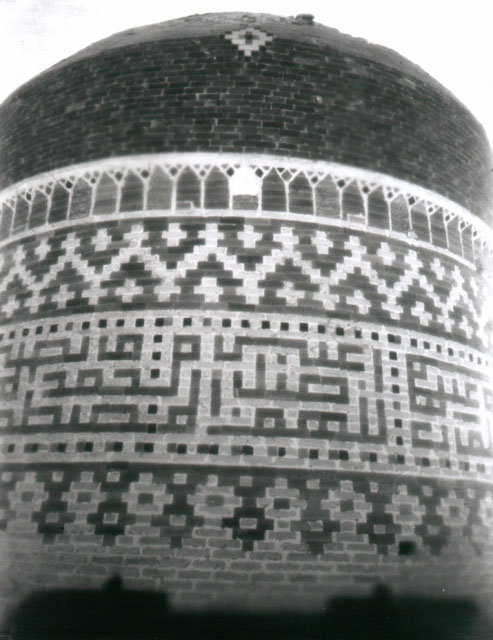is remarkable for a domed stalactite ceiling
It is the 12th April 1934 and Byron’s just paid a visit to the tomb tower of Chelabi Oghlu. After that, he reports his visit to the Shrine of Mullah Hassan-i Kashan. What Byron writes about it is only that the most interesting feature of this monument is the ceiling of the dome, made of colored muqarnas (stalactite) in red and white: “[it] is remarkable for a domed stalactite ceiling painted red and white.”

It is weird that Byron talks about the painted ceiling as the most remarkable feature of the monument, considering that he did not take even one single photo of the interior of the monument. Even weirder is the fact that he does not mention at all the square Kufic inscriptions that decorate the building almost everywhere.
Not much information can be found on the Shrine of Mullah Hassan-i Kashan. Some detailed info can be found in a UNESCO report, in which the Dome of Sultaniyya is nominated as World Heritage Site. There, also nearby monuments are described briefly, one of these being this shrine.

We learn then that the Shrine was built for the Mullah Hassan-i Kashan, poet and religious figure connected to the court of Uljaytu. From the outside, the monument appears to be octagonal, but in fact, the internal chamber has a square plan: the square hall has additional galleries at the corners, giving the aspect of an octagon to the monument if seen from the outside. The interior decoration in stucco that Byron mentions, does not belong to the original construction but was a later addition, done during the Qajar period, in the early 19th century.

What is more remarkable are the square Kufic inscriptions that decorate the drum of the dome, the arches and the recesses that are on the walls of the monument. But Byron was not impressed by them, apparently.
Sources
Nomination file 1188, UNESCO World Heritage Center, p. 23. [available online (last accessed: 28th March 2018)]
For additional photos, go to archnet.org.